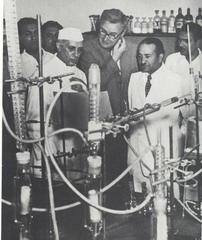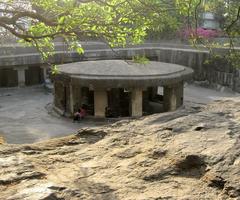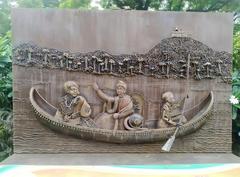Tulshibaug Rama Temple: Visiting Hours, Tickets, and Pune Historical Sites Guide
Date: 04/07/2025
Introduction
Situated in the vibrant heart of Pune’s Budhwar Peth, the Tulshibaug Rama Temple stands as a beacon of religious devotion, Maratha-era architecture, and community life. Established in the late 18th century under the patronage of Naro Appaji Khire, the temple is a spiritual center dedicated to Lord Rama and a living testament to Pune’s historical legacy. Enveloped by the bustling Tulshibaug market, the temple uniquely blends sacred space with commercial activity—a microcosm of Pune’s cultural fabric. This guide provides a detailed overview of the Tulshibaug Rama Temple, including its history, architectural features, visiting hours, ticketing, accessibility, major festivals, practical travel tips, and nearby attractions. Whether you are a devotee, history aficionado, or cultural explorer, this article equips you with everything you need for a memorable visit. (Tulshibaug Devasthan Trust, Travelogue Unlimited, Pune Tourism)
Historical Background
Origins and Patronage
The Tulshibaug Rama Temple traces its roots to the aftermath of the Third Battle of Panipat in 1761 CE. Built during the Peshwa era, construction commenced in 1763 under Naro Appaji Khire, the then Subhedar of Pune. By its completion in 1795, the temple had become both a spiritual nucleus and a catalyst for economic activity, drawing traders, artisans, and devotees to the area. The main sanctum houses black stone idols of Lord Rama, Sita, and Lakshmana, crafted by Umajibaba Pandharpurkar in 1765. Over time, additional shrines for Hanuman, Ganapati, and Parvati were added, adorned with precious metals and stones, reflecting the temple’s historical affluence. (Wikipedia)
Evolution and Conservation
Despite Pune’s evolution and the challenges of colonial rule and urbanization, the Tulshibaug Rama Temple has remained at the heart of the city’s cultural identity. The Tulshibaug Devasthan Trust and Shree Ramji Sansthan have overseen periodic restorations, focusing on preserving the temple’s original woodwork, lime plaster, and stone carvings. Conservation efforts have ensured the temple’s continued role as a community and religious hub. (Tulshibaug Devasthan Trust)
Architectural Highlights
Layout, Structure, and Features
The temple exemplifies classic Maratha architecture, with a design that harmonizes sacred and public spaces. The main sanctum (garbhagriha) is flanked by a sabhamandap (assembly hall) featuring intricate wooden pillars and brackets. The iconic shikhara (spire), completed in 1884 by Nandram Naik, rises above the sanctum with ornate stucco work and mythological motifs. Auxiliary shrines to Hanuman, Ganesh, Shiva, and other deities are positioned to facilitate ritual circumambulation.
A tulsi vrindavan (basil plant enclosure) graces the courtyard, symbolizing spiritual and ecological significance. The adjoining wada (traditional residence) integrates religious, residential, and commercial functions, reflecting the holistic urban design of the Peshwa era. (Wikipedia)
Artistic and Cultural Elements
The temple is adorned with murals depicting scenes from the Ramayana and features gold and silver embellishments. During festivals, the temple is illuminated and decorated with floral garlands, while devotional music and rituals enliven the atmosphere. (My Yatra Diary)
Essential Visitor Information
Visiting Hours
- Daily: 6:00 AM to 9:00 PM (general consensus from official and travel sources)
- Festival Days: Extended hours during major festivals such as Ram Navami and Ganeshotsav
Entry and Tickets
- Entry Fee: Free for all visitors
- Guided Tours: Available upon request through the Shree Ramji Sansthan or local heritage groups; advance booking is recommended for groups
Accessibility
- Location: Central Pune, near Bajirao Road and Laxmi Road; easily accessible by public transport
- Wheelchair Access: Main entrance and courtyards are accessible, though some internal areas may have steps or uneven flooring
- Facilities: Cleanliness is maintained; rest areas and shaded benches are available; restrooms and drinking water may be crowded during festivals
Dress Code and Etiquette
- Modest clothing covering shoulders and knees is required
- Shoes must be removed before entering the main temple area; bring a bag for footwear
- Silence is appreciated inside the sanctum; mobile phones on silent
- Photography is prohibited inside the sanctum and main halls, but permitted in the exterior areas and market
Rituals, Festivals, and Community Life
Major Festivals
- Ram Navami: The temple’s grandest festival, with special pujas, Ramayana recitations, floral decorations, and prasad distribution (Sandeep Godbole Blog)
- Hanuman Jayanti: Celebrated with abhishekas, chanting, and processions in honor of the temple’s revered Hanuman idol (Treebo Blog)
- Ganeshotsav: The Tulshibaug Ganpati Mandal, adjacent to the Rama Temple, is renowned for its 15-foot idol and elaborate silver decorations (Latestly)
- Other Festivals: Diwali, Dussehra, and Makar Sankranti are celebrated with special rituals and vibrant illuminations
Cultural Programs and Community Engagement
- Bhajan and Kirtan Evenings: Regular devotional music sessions and storytelling in the sabhamandap (Kevin Standage Photography)
- Spiritual Discourses: Occasional workshops and lectures on Hindu scriptures
- Charitable Initiatives: Food distribution, health camps, and educational support during festivals
Tulshibaug Market: Commerce Meets Spirituality
Market Experience
The Tulshibaug market, enveloping the temple, is one of Pune’s oldest and most vibrant bazaars, especially lively during festivals. Vendors sell puja items, brass and copperware, traditional jewelry, household goods, and festive decorations. The market’s historic origins add depth to the visitor experience, and street food vendors offer local delicacies such as misal pav, vada pav, and modaks (Atlas Obscura).
Nearby Attractions
- Shaniwar Wada: Historic Maratha fort and palace within walking distance
- Dagdusheth Halwai Ganapati Temple: Iconic Ganesh temple, a short auto ride away
- Mahatma Jyotiba Phule Mandai: Pune’s largest vegetable market, ideal for street photography
Practical Visitor Tips
- Best Time to Visit: Early mornings or late evenings for tranquility; festival days for a vibrant atmosphere (expect crowds)
- Plan Your Transport: Use public transport or park at designated lots nearby
- Hydration: Carry water, especially during warmer months
- Combine Activities: Explore the temple and market together for a holistic experience
- Respect Customs: Adhere to dress code, silence, and photography restrictions
Frequently Asked Questions (FAQ)
Q: What are the Tulshibaug Rama Temple visiting hours?
A: 6:00 AM to 9:00 PM daily, with extended hours during festivals.
Q: Is there an entry fee?
A: No, entry to the temple is free.
Q: Are guided tours available?
A: Yes, upon request through the temple trust or local heritage groups.
Q: Is the temple accessible for differently-abled visitors?
A: Main areas are accessible; some internal areas may present challenges.
Q: What are the best times to visit?
A: Early mornings on weekdays for peace, or during major festivals for vibrant celebrations.
Q: Is photography allowed?
A: Not inside the sanctum or prayer halls; permitted in exterior areas and the market.
Visuals and Media
Enhance your visit or presentation with high-quality images of the temple’s shikhara, intricate woodwork, festival scenes, and bustling market. Use alt tags such as “Tulshibaug Rama Temple Pune main entrance” or “Festive decorations during Ganeshotsav at Tulshibaug Temple.” Virtual tours and interactive maps are available on Pune tourism websites.
Conclusion
The Tulshibaug Rama Temple is a cornerstone of Pune’s spiritual, historical, and cultural landscape. Its harmonious blend of devotion, architectural splendor, and community life makes it a must-visit destination in the city. Whether you come for worship, history, or to experience the vibrant market and festivals, the temple offers a unique window into Pune’s enduring legacy.
For the latest updates, guided tours, and event information, consult the Tulshibaug Devasthan Trust and local tourism resources. Enhance your journey with the Audiala app for curated travel guides and real-time updates.




